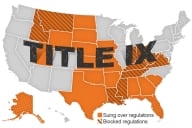You have /5 articles left.
Sign up for a free account or log in.
The “misperception” that all Asian-American and Pacific Islander students are high-achieving and immune from financial challenges has created barriers for the fastest-growing minority group in the United States, says a study released today.
The study finds that colleges that have been designated as serving Asian-American and Native American Pacific Islander students could significantly support low-income students from those groups and help bust the "model minority" myth. But relatively few of those colleges have qualified so far to receive funds through the federal program set up for that purpose.
The report -- which was issued by the Asian and Pacific Islander Scholarship Education Fund and the National Commission on Asian-American and Pacific Islander Research in Education -- says that of the 153 institutions that are eligible to be Asian American and Native American Pacific Islander-Serving Institutions (AANAPISIs), only 21 are now receiving funding.
The Asian American and Native American Pacific Islander-Serving Institution program is a competitive grant process for institutions that serve high concentrations of low-income Asian-American and Pacific Islander students. In 2011, the Department of Education placed AANAPISIs on the official list of minority-serving institutions.
In the summer of 2012, the Asian and Pacific Islander Scholarship Education Fund and the National Commission on Asian-American and Pacific Islander Research in Education launched a three-year, $2 million effort funded by various organizations, the Partnership for Equity in Education Through Research. The three institutions that are participating in the PEER project are the City College of San Francisco, De Anza College in California, and South Seattle Community College. Each institution was free to use the grant money in whatever way it saw best, including developing programs, hiring counselors and offering support services — all intended to increase AAPI student success.
The study that was released today assessed the impact of these programs, so the most effective strategies could be replicated in other institutions around the country, said Neil Horikoshi, director and president of the Asian & Pacific Islander American Scholarship Fund.
“It is a fact that there is a lack of research and understanding not only about AAPI students, but more importantly, there is literally no scholarly research on students attending [AANAPISI] campuses,” Horikoshi said. A main goal of the project and the study, he said, was “evaluating and confirming the best practices and interventions” for students at these institutions.
Evaluating how AANAPISIs can be most effective with their funding to “get the biggest bang for their buck” is important, said Robert T. Teranishi, associate professor of higher education at New York University and principal investigator for the report. “There hasn’t been a lot of assessment of minority-serving institutions to see what they’re doing with their funding and assess what the outcomes are.”
By providing academic, non-academic and professional support services, students at the three AANAPISI colleges that received the PEER grant had more “guidance and support,” “access to role models and leadership opportunities,” and student respondents said they felt “more understood on campus,” the study says.
In addition, there was “more community engagement,” and a “changed perception of AAPI students on campus.”
The researchers drew on interviews, campus observations and reviews of grant grant proposals and budgetary documents to make their conclusions. While many students and faculty expressed positive changes in their campus communities as a result of the grant, the study did not identify progress on any data-driven academic outcomes for the students who attended the funded AANAPISIs.
Brian Murphy, president of De Anza college, said at a time of dramatic state funding cutbacks in California, which have had a particularly negative effect on community colleges like his, the grant allowed De Anza to create an “infrastructure” that focused on Asian-American students.
More than just that, being designated as an AANAPISI had a “social and political impact,” Murphy said, because it provides space for multiple “narratives and voices.”
De Anza has more than 3,500 Mexican American students, and a solidarity has emerged between Asian and Latino students following De Anza's AANAPISI designation. Murphy said. He said the grant has allowed the college to experiment with different pedagogies -- many of which have been replicated for Latino students on campus.
The study highlights the effects AANAPISIs can have on student success, but if programs such as the ones at these three campuses are to continue to thrive, the study suggests, there is much more work to be done.
One hurdle AANAPISI advocates face is simply getting the word out about their existence. An institution is eligible to be an AANAPISI if at least 10 percent of its students are Asian American or Pacific Islander, and if at least 50 percent of its entire student body has demonstrated financial need. Currently, 153 2-year and 4-year institutions are eligible, but only 78 have submitted a request to the Education Department to become “designated.”
Horikoshi attributes this to a number of factors. First of all, there are a lot of campuses that simply do not know they qualify to be recognized as AANAPISIs. That is one reason that studies like this one and outreach programs are so important, Horikoshi said. But the biggest problem for eligible AANAPISIs is the lack of federal funding available for them. According to the study, only 14 percent of the institutions eligible to be AANAPISIs and 27 percent of the designated institutions are funded.
“Current budget appropriations for the program do not meet the need or demand, which would require an additional $22.8 million per year over the current level of funding to provide grants to all of the designated AANAPISIs,” the study says. “To fund all eligible AANAPISIs would require an additional $52.8 million per year over the current level of funding.”
This study is one in a series of reports from the Commission on Asian American and Pacific Islander Research in Education and the Asian and Pacific Islander Scholarship Education Fund, which will address further questions about AAPI students and AANAPISIs.
Today the Asian & Pacific Islander American Scholarship Fund is hosting its fourth annual higher education summit in Washington, D.C., where the report will be released for hundreds of college presidents, education leaders, students, policymakers, federal government officials and corporate executives from across the nation. This event will focus on increasing college completion and student success among Asian-American and Pacific Islander students and strengthening the capacity for AANAPISIs.








